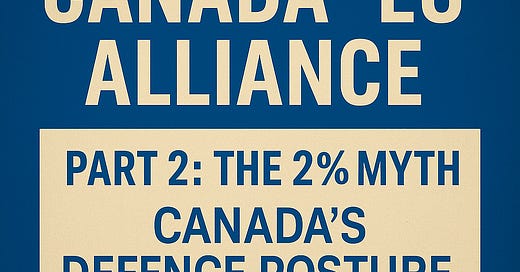Link to Part 1 “Why Canada Joining Europe’s Rearmament Plan Is a Strategic Power Move”

We’ve heard it for years—Canada doesn’t spend enough on defence. But what if the number isn't the full story?
The Quiet Build-Up, Part 2: The 2% Myth — Canada’s Real Defence Posture
We’ve heard it for years—Canada doesn’t spend enough on defence. But what if the number isn't the full story?
As G7 statements echo louder this weekend, it’s time to push back with substance. Canada’s critics clamour for metrics. What we offer—access, capacity, credibility—rarely fits neatly into a spreadsheet. The 2% GDP spending target, agreed to by NATO members in 2006, is a political shorthand—not a true measure of readiness.
Yet this number continues to dominate headlines, even though only 11 of 31 NATO nations hit the mark in 2023, despite escalating global threats. Canada, ranked 25th by percentage, still lands in the top 10 for real-dollar contributions and interoperability—an inconvenient fact for the “Canada’s slacking” crowd.
The 2% Illusion
Let’s be clear: 2% isn’t a destination—it’s an annual open tab.
In 2024/25, Canada is spending about C$44 billion, or ~1.37% of GDP. Reaching 2% in 2025/26 will mean adding at least C$9.3 billion, for a total around C$62.7 billion—and that’s just to qualify. If our economy grows, so does the expected spend.
What’s more, new NATO proposals could push expectations up to 5% when including infrastructure investment. That’s not just a budget tweak—it’s a generational shift in fiscal planning.
What 2% Ignores
The obsession with 2% misses what Canada actually brings:
Personnel & Deployment – leadership roles in Latvia, Iraq, Ukraine training
Cyber & Intelligence – Five Eyes member, CSE, EU/NATO AI security sharing
Geography & Interop – NORAD modernization, Arctic logistics, allied airfields
Procurement & Industry – co-production with EU suppliers, Gripen jet negotiations
Canada’s defence role is strategic, not symbolic. Our contributions are often force multipliers, not just troop tallies.
"2% doesn’t equal prepared. And 2.2% doesn’t equal dependable."
The Real Commitment
Reaching 2% isn't a one-time announcement. It’s a fiscal runway, demanding stability, policy clarity, and long-term funding. Even if we hit it in 2026, we’ll need to sustain and grow that commitment annually—under minority governments, fluctuating economies, and growing domestic pressures.
This isn’t about writing one big cheque. It’s about recalibrating what Canadian defence means in a world where Arctic sovereignty, cyber war, and joint infrastructure matter more than ever.
Final Word
Canada’s defence story is more than a ratio. It’s about what we enable, who we train, what we protect, and where our allies land when crises erupt. The number matters—but the function matters more.
🟢 Missed Part 1? Read how Canada’s unexpected role in the EU’s rearmament strategy revealed a quiet but pivotal realignment of global defence.
🟢 Stay tuned for Part 3, where we dig into how Canada’s NATO commitments could reshape domestic infrastructure priorities.
💚 If this brought you new perspective, tap the heart or share—it helps this series reach others who care about where Canada stands.Ensure you don’t miss out on any installment in this series. No spam, weekly digest delivered straight to your inbox.
For the overworked, the underpaid, and the deeply curious.
💬 Wry truth-telling. 🧠 Accessible analysis. 🎯 Actionable insight.
🟢 Want more context like this? Tap the 💚 or share this post with someone who thinks defence is just about budgets. It’s about power—and who gets to shape it. Leave a comment and let me know what you’d like to see me expand on in this series. -Leni



